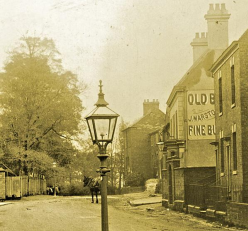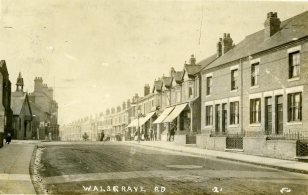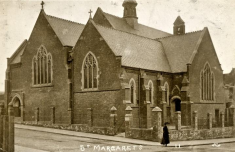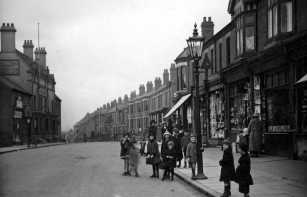CovSoc member John Marshall tells us the fascinating history of one of Coventry’s best known suburbs. John writes….

It’s difficult to imagine Ball Hill as anything other than a typical suburban shopping centre, with its lengthy row of shops on either side of the road, punctuated occasionally with a café, a betting shop or post office. But, of course, it was not always so.
In the nineteenth century Ball Hill was still a tiny hamlet with little more than a sprinkling of cottages, a Congregational church (opened in 1836) and an old pub, known at that time as The Ball Inn. The whole area was usually referred to as The Ball, after the pub, and seems not to have acquired its current moniker ‘Ball Hill’ until later. The hamlet only became part of Coventry with the boundary changes of 1899.
At some point The Ball Inn became known as the Old Ball and by about 1907 it seems to have been significantly enlarged. That coincided with the very rapid development of the area, with new houses being built along Walsgrave Road from Gosford Green to Clay Lane.
New streets, like Marlborough Road, St Michael’s Road, Clements Street and Kingsway, also appeared on either side of the main road and Ball Hill suddenly emerged as the busy heartland of a new Edwardian suburb.
But even then, Ball Hill did not instantly become a shopping centre, nor was it designed as such. True, there were shops on this part of Walsgrave Road but most of the new buildings on either side were houses, not retail stores.

The photograph above, showing Ball Hill at its junction with St Michael’s Road in about 1911, illustrates the point superbly. The corner shop is Vincent Wyles, the butcher – now the Smile Centre and remembered by many as the former PDSA. But other buildings in 1911 – on both sides of the road – are houses, not shops, with tiny front gardens.
In the years that followed, some owners of those houses converted their front rooms into shops and gradually more owners followed suit. The end result was the familiar shopping parade we know today, with former front gardens now displaying goods for sale. Another notable feature of this photograph is the trees in the distance, indicating that urban development at this stage had not gone beyond the junction with Clay Lane and Bray’s Lane. Here the new suburb stops, the road narrows, trees line either side, and the road slopes gently down towards the semi-rural surroundings of Stoke Church.
Only in later years did urbanisation expand beyond this point. As houses and shops developed on Ball Hill, so too did social, religious and educational facilities. The Congregational church had started life in 1836 but this proved inadequate for the rising population of Stoke in the early years of the twentieth century. An additional temporary building was constructed by the church in 1907 and this provided extra space for activities like sewing classes and a men’s social club, in addition to church services and Sunday schools.

By 1910, a much bigger church, St Margaret’s (pictured below), was constructed on Ball Hill, on a sizeable plot of land on the corner of the new Argyll Street. It was built by a local firm, Garlicks, in red brick, and opened for worship in the following year. Shortly afterwards, a Church Hall and Institute was built near the church, and this became a major centre for social life in the area, providing facilities for social clubs, dance classes and numerous sporting activities, as well as choir practice and Bible classes. The building still exists but is now known as the Churchill Hotel.

Another addition to Ball Hill in those early years was a new public library, one of three new branch libraries built in Coventry with funds from Andrew Carnegie, the Scottish-American businessman and philanthropist. The library sat on the corner of Kingsway, at the bottom of the hill, and was opened in 1913. Carnegie visited the library in the following year, during a trip to Coventry to receive the honorary freedom of the city. He was escorted by the Mayor Siegfried Bettmann, the founder of Triumph and a resident of nearby Stoke Park.
In due course Ball Hill even had the luxury of an outdoor swimming pool, located behind Kingsway, on a strip of land beside the railway line, signifying a final step in the enormous leap from rural hamlet to thriving suburb in an expanding industrial city.

John Marshall
This story appeared in the January 2023 edition of the newsletter of the Stoke History Group with the kind permission of their Chair, John Marshall. Photographs courtesy of David Fry and Rob Orland.
